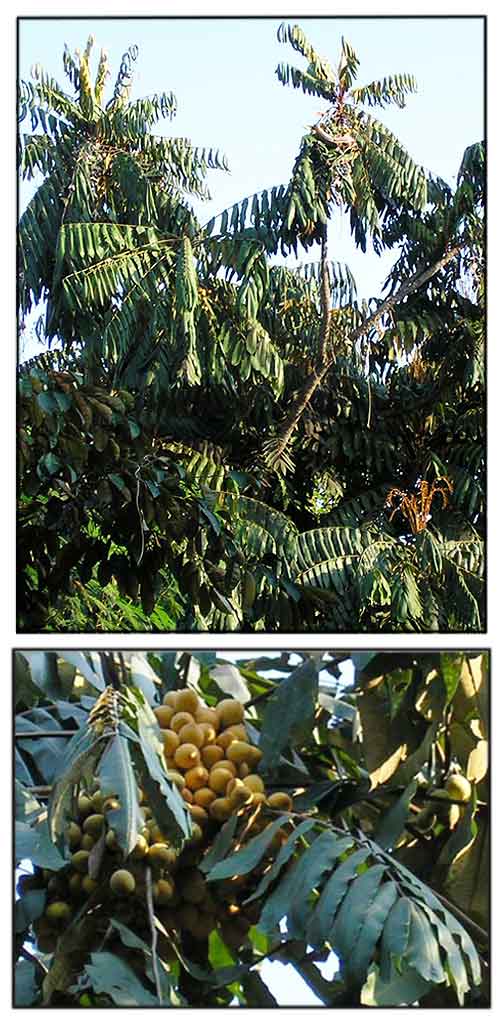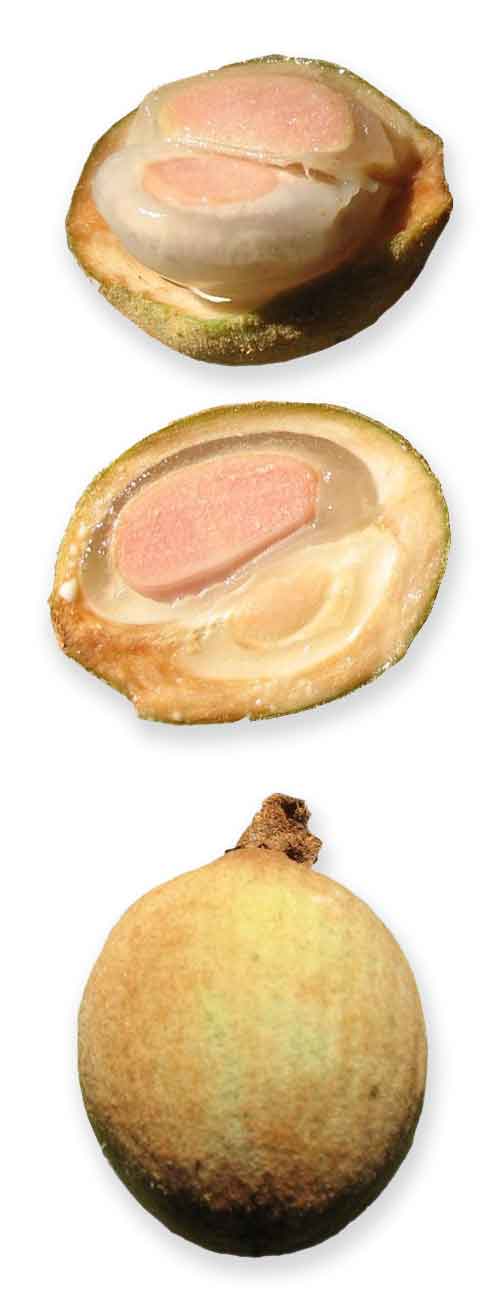 Gen info Gen info
- Aglaia is a genus of 121 recognized species of woody dioecious trees in the mahogany family Meliaceae. It is the largest genus in the mahogany family.
-
They are distinguishable morphologically, mainly on fruit characteristics and number of flower parts. The timber of may Aglaia species is used for house-building, fence posts, canoes, paddles, axe-handles, spear-shafts, and firewood. The fragrant flowers are
used for scenting tea and for perfuming cupboards, and protecting clothing from moths.
- The genus was created in 1790 by Loureiro in homage to
one of the three graces of Greek mythology, Aglaia or Aglae.
Botany
• Tree up to 27 m, sometimes small and unbranched. Bark smooth, gray, with shallow longitudinal fissures; inner bark brown or dark brown; sapwood pinkish-brown, brown or yellow; latex white. Leaves in spirals towards the ends of the twigs where they are very close together and the expanded bases of the petioles overlap, imparipinnate, up to 135(–200) cm long and 80 cm wide; petiole up to 20 cm long, up to 2 cm across at the base, petiole, rachis and petioles with indumentum like the twigs; latex white. Inflorescence up to 30 cm long and 15 cm wide, the final branches up to 20 mm long and densely packed with sessile flowers; peduncle up to 7 cm, peduncle, rachis and branches clothed like the twigs Flowers up to 2 mm in diam. Petals 5, c. 1.5 by 0.6 mm. Staminal tube c. 1 mm long, shorter than the corolla, subglobose with the aperture wide and deeply 5-lobed; anthers 5, ovoid, half to nearly as long as the tube and just protruding through the aperture. Fruits brown, up to 5 cm long and 4.5 cm in diam., obovoid, sometimes with a small beak, with a thick indumentum of hairs up to 4 mm long like those on the twigs, fruitstalks up to 2 cm. (Flora Malesiana)
Distribution
- Native to the Philippines.
- Also native to Borneo, Cambodia, Laos, Malaya, Myanmar, Sulawesi, Thailand, Vietnam. (1)
- It was classified as "Near Threatened" in the IUCN Red List of Threatened Species (2013).
Constituents
- Study of stem bark isolated five sesquiterpenoids: 7-epi-eudesm-4(15)-ene,1β,6α-diol (1), 7-epi-eudesm-4(15)-ene,1β,6α-diol (2), saniculamoid D (3), aphanamol I (4), and 4β,10α-dihydroxyaroma-dendrane (5). (see study below) (3)
- Study of leaves isolated three pregnanes and two known cycloartane-type triterpenoid hydroperoxides. (4)
- Study of leaves isolated three putrescine (i.e. 1,4-butanediamine) bisamides (1-3) and a known aromadendrane-type sesquiterpene (4). (5)
- Study of twigs isolated a new sesquiterpene derivative,
6α-hydroxy- eudesm-4(14)-en-1-one, three known sesquiterpenes and two known pregnane-type steroids. (7)
Properties
- Understudied plant.
 Uses Uses
Edibility
- Fruit is edible, raw, highly acidic, think translucent pulp.
- Used by Lao in culinary preparations such as tam som (acid salad). (2)
- In Vietnam, fruits used in local food preparation, such as sour soup. Also used for making traditional alcohol.
Folkloric
-
No reported folkloric medicinal use in the Philippines.
-
The Lao use the plant for "cleansing" and treatment of "foot scab". (2)
Studies
• Sesquiterpenoids / No Cytotoxicity / Stem Bark: Study of stem bark isolated five sesquiterpenoids: 7-epi-eudesm-4(15)-ene,1β,6α-diol (1), 7-epi-eudesm-4(15)-ene,1β,6α-diol (2), saniculamoid D (3), aphanamol I (4), and 4β,10α-dihydroxyaroma-dendrane (5). The compounds were evaluated for cytotoxic effects against Hela cervical and B16F10 melanoma cells, but showed no significant effect. (3)
• Flavaglines / Highly Bioactive Flavolignans from Aglaia Species: Flavaglines are a cycloaddition of a flavonoid nucleus with a cinnamic acid moiety representing a typical chemical character of the genus Aglaia of the family Meliaceae. Based on biosynthetic considerations 148 derivatives are grouped together into three skeletal types representing 77 cyclopenta[b]benzofurans, 61 cyclopenta[bc]- benzopyrans, and 10 benzo[b]oxepines. A wide variety of biological activities ranges from insecticidal, antifungal, antiprotozoal, and anti-inflammatory properties, especially to pronounced anticancer and antiviral activities. The high insecticidal activity of flavaglines is comparable with that of the well-known natural insecticide azadirachtin. Some possess comparable cytotoxicity to the natural anticancer compounds paclitaxel (Taxol®) and camptothecin without affecting normal cells. Flavaglines were shown to be not only promising anticancer agents but gained now also high expectations as agents against emerging RNA viruses like SARS-CoV-2. (8)
Availability
Wild-crafted. |

![]()





